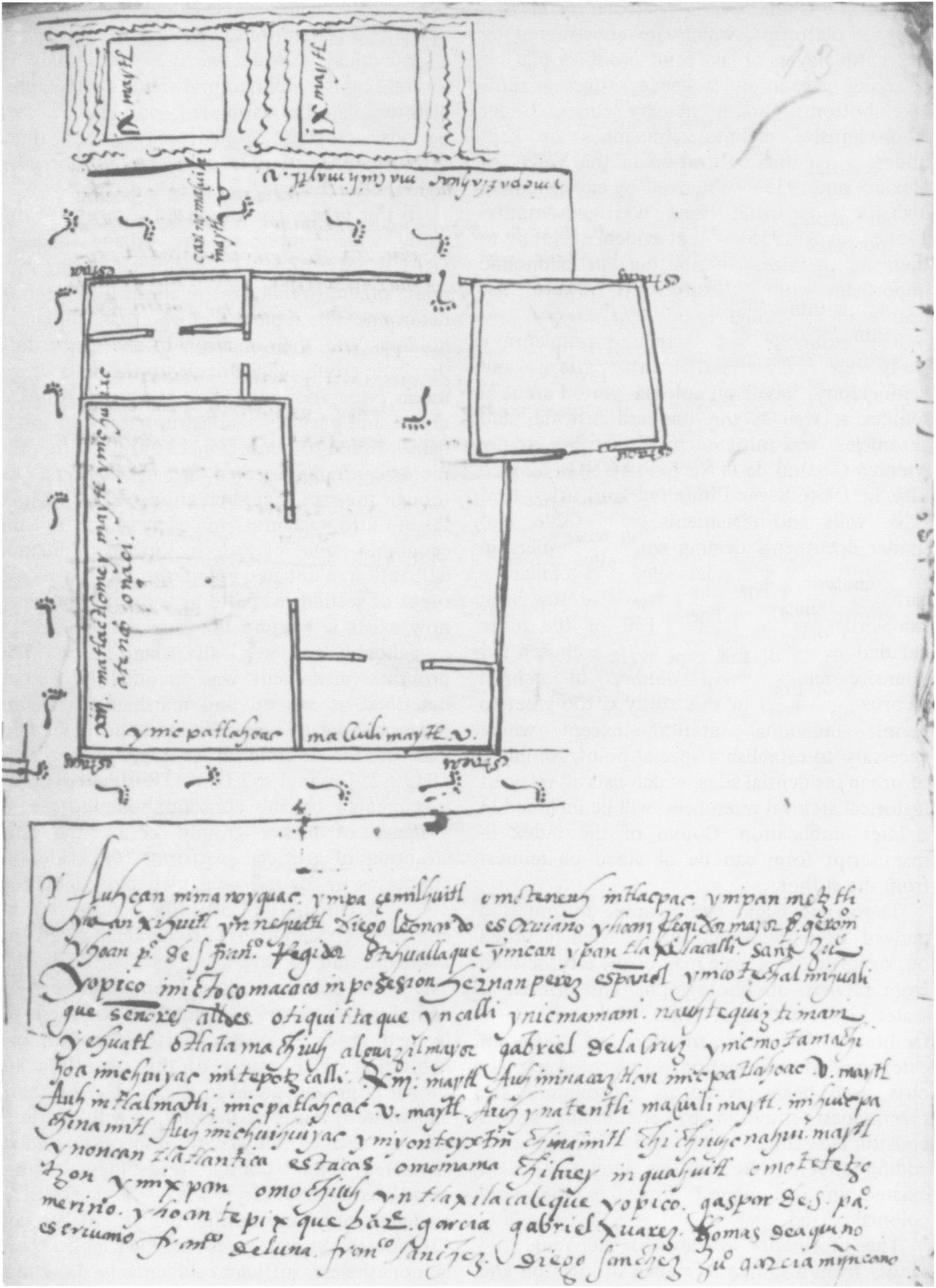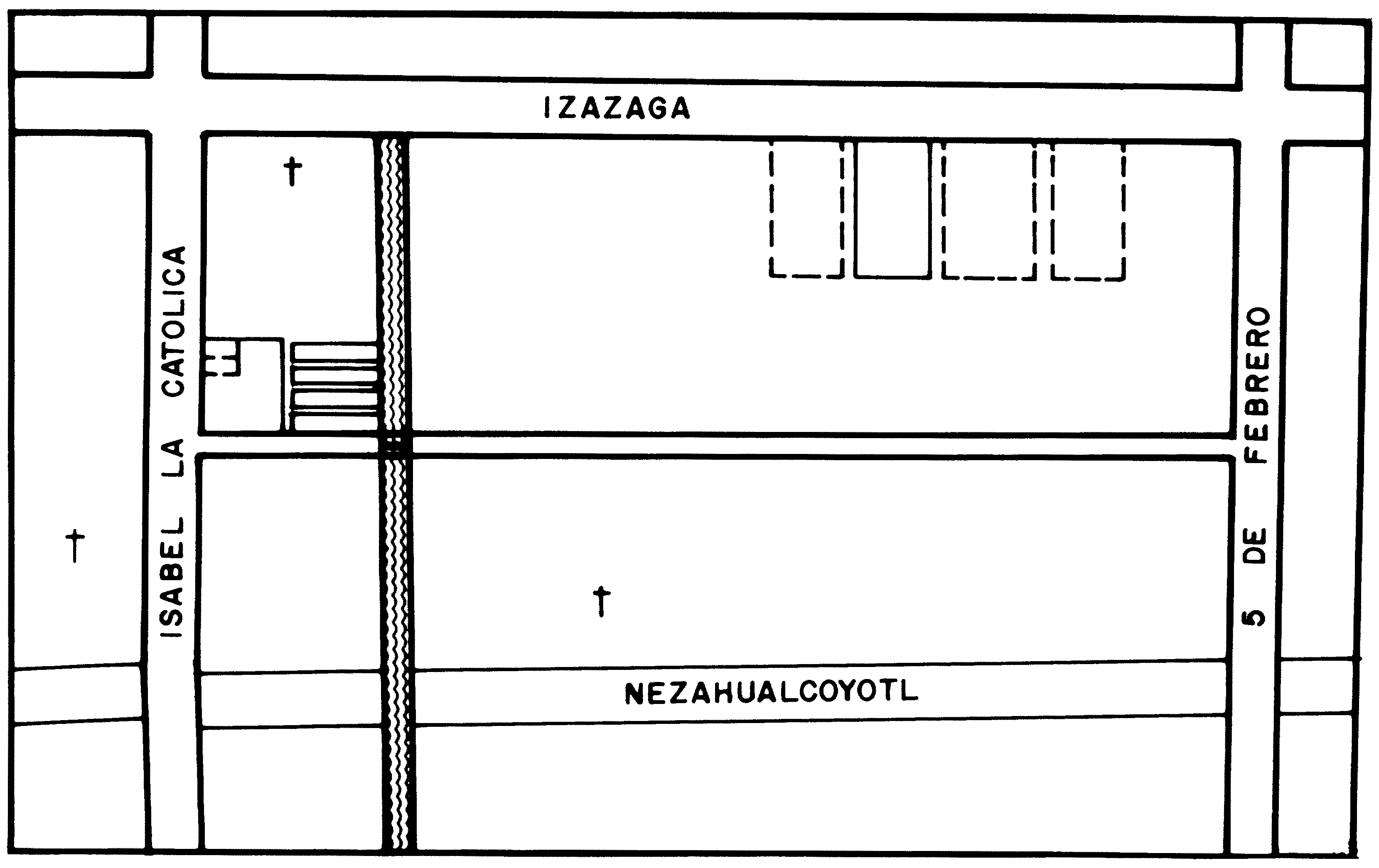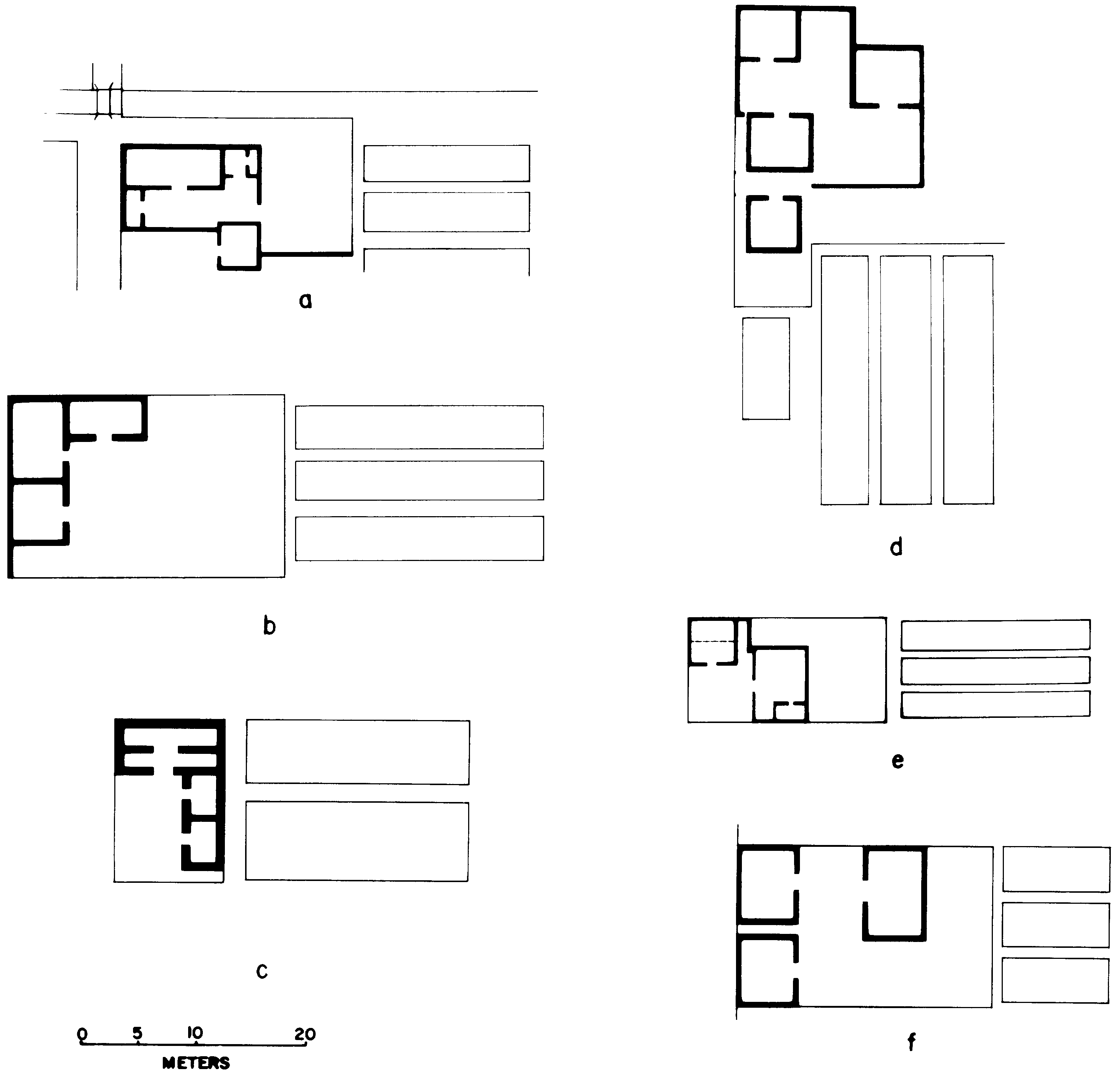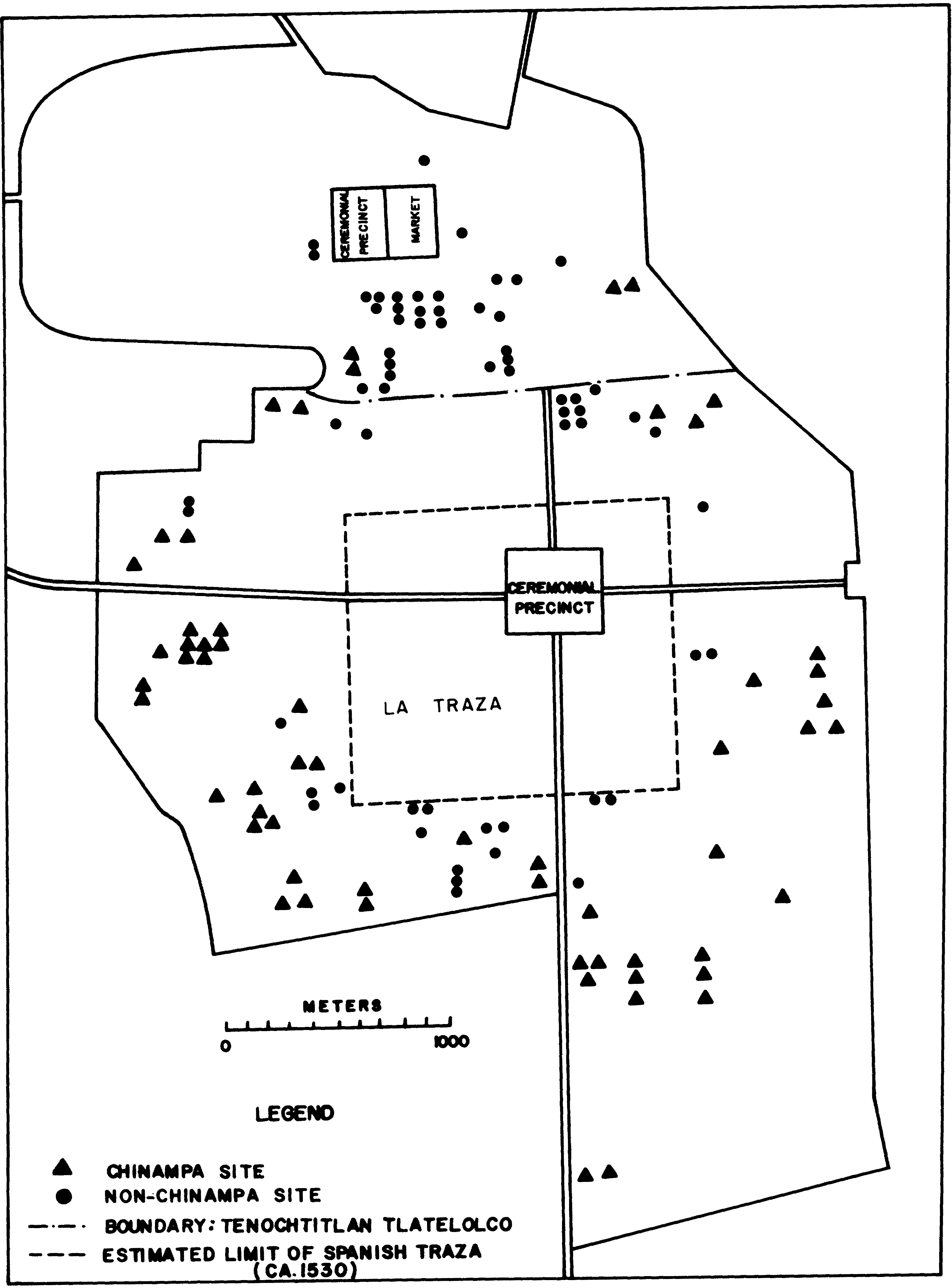
Settlement Pattern and Chinampa Agriculture at Tenochtitlan
Edward E. Calnek
Archival source materials and colonial period maps have been employed to reconstruct the settlement pattern characteristic of the chinampa districts of the Aztec capital, Tenochtitlan. The evidence includes detailed descriptions of a number of individual residential sites and chinampa holdings, which can be drawn to scale on street maps of the modern city. Genealogies and census data have been employed to determine the average size and social composition of typical urban households. Rough estimates of the economic value of urban chinampa holdings in relation to individual households, and to the urban population as a whole, indicate much higher levels of nonagricultural economic specialization, and a more complete dependence of the city on agrarian support areas outside the city than previously supposed.
Department of Anthropology University of Rochester October, 1970
The ruins of the Aztec capital, Tenochtitlan, underlie the heart of modern Mexico City. As a consequence, archaeological investigations have been possible only as an adjunct to construction activities. Their results are necessarily limited in scope. No map of the preconquest city has yet been located in European or New World archival collections. The earliest detailed map of the colonial city dates to 1628-more than a century following the Spanish conquest (Carrera Stampa 1949, Lam. XII). The conquistadores describe the temples, pyramids, palaces, and other monumental structures of the city as they existed on the eve of the conquest but make only passing reference to the situation in the ordinary residential districts.
Despite the wealth of documentary evidence bearing on Aztec social organization in late prehispanic times, virtually nothing has been known about the physical characteristics of their capital city until now. Thus, the boundaries, and therefore the total area, of the city have never been established on empirical grounds. Population estimates range from 60,000 to 300,000 inhabitants even in recent publications (Willey 1966:157; Sanders and Price 1968:151). The relation of the city to agriculture has been especially problematic. The existence of artificial gardens called chinampas within the city is mentioned in early historical sources (Berlin 1948:52; Tezozomoc 1944:379). Chinampas are narrow, rectangular beds or platforms, which are constructed by alternating layers of lake mud and thick mats of decaying vegetation (cespedes) over shallow lake bottoms, or in marshy zones. Under labor-intensive regimes, chinampas are kept under continuous cultivation in the Valley of Mexico, and are characterized by exceptionally high yields per unit of land (West and Armillas 1950; Palerm 1955). Direct evidence relating to their actual size, distribution, or economic importance within the city itself, however, has been notably lacking.
To resolve these and related problems, a study of urban settlement pattern and demography, based on colonial period archival sources as well as the standard histories and chronicles, was initiated by the author at the Archivo General de la Nacion (AGN) in Mexico City in 1966. Several hundred land titles, land suits, wills and testaments, bills-of-sale, and similar documents dealing with the ownership of individual residential sites and chinampa gardens located within the city have now been examined. Approximately 150 of the more detailed records of this type were chosen for intensive analysis. The number of archival records employed in this study is too great to permit individual citation, except where necessary to establish a special point. An index of urban residential sites, which lists all relevant historical archival references, will be included in a later publication. Copies of the index in manuscript form can be obtained on r from the author.
Topographic and demographic information derived from these s irces has be recorded on, or keyed to, a scale map of the city, scribed from modern air photographs, and printed at scales of 1:10,000, 1:5000, and 1:2000, to facilitate the representation of different categories of information. Modern street layouts have been revised to approximate the preconquest situation by eliminating streets constructed since 1521, and identifying or adding streets that can be shown to have existed in preconquest times or the early colonial period.
The information available for individual sites ranges from a simple reference to location and the presence or absence of chinampas, to detailed ground plans (Fig. 1), which can be redrawn to scale at or near their original locations on the base map. It has also been possible to compile genealogies spanning as many as 5 generations at a single site, or lists of all individuals in residence at a specific time. In several cases, architectural and demographic histories can be correlated, and traced over periods ranging from preconquest times through the end of the seventeenth or even eighteenth century.
In this paper, I summarize the results of this study which apply to the urban chinampa districts. My principal objectives during this phase of the overall investigations have been to determine the typical size of urban chinampa holdings and their relation to the elementary domestic groups which made up the mass of the urban population. Evidence is also available to define and partially reconstruct zones of much denser house-to-house concentration within the more centrally located urban districts. Although the fact that such areas existed must be taken into account in evaluations of the economic role played by urban chinampa cultivation, a detailed comparison of the several types of settlement patterns for which evidence now exists is beyond the scope of this article.
Tenochtitlan was an island city. The primitive settlement was founded in a zone described as swamp and marshland near the western shore of Lake Texcoco during the first half of the fourteenth century (Tezozomoc 1949:62; Duran 1967 II:48). Residential space was created by the consolidation and partial drainage of higher ground or by the construction of artificial platforms for residential structures or for use as garden plots (Rendón 1965:78; Duran 1967:50). Fig. 2 illustrates the city as it appeared in 1519 in relation to the mainland and to several of its island colonies. The urban boundaries have been determined by compiling references to points said to have been located at or near the limits of continuous habitation. The results of this operation are shown in greater detail in Fig. 3. The northern and western limits of the city, it will be noted, can be defined only with respect to widely separated base points, and may require significant revision when archaeological evidence obtained during the recent Mexico City Metro excavations is made available. There is, nonetheless, sufficient evidence to show that the urban area was not smaller than 12 km² (excluding Nonoalco, which cannot yet be accurately mapped). Revised estimates are expected to result in an increase rather than a decrease in this figure. In any case, the city appears to have been significantly larger than supposed by previous investigators, who have generally cited a figure of approximately 7.5 km² (Toussaint, Gomez de Orozco, and Fernandez 1938:72).
The approximate positions of a number of smaller island communities have also been determined from archival records and colonial period maps. Their boundaries, however, cannot be accurately fixed at the present time. Several were primarily chinampa communities; others combined agriculture with salt-making, mat weaving, fishing, adobe manufacture, and other specialized occupations (see, for example AGN Tierras, Vol. 45, Exp. 2 and Vol. 49, Exp. 5).
The layout of the major urban canals, and several of the more important streets, is shown in Fig. 3. Six major canals can now be identified. Five canals flowed through the city from west to east. Some or all of these originated at mainland rivers to the west (Linné 1948, End Map; Cervantes de Salazar 1953:76). A sixth canal extended south to Lake Xochimilco. The larger canals on the east-west axis were linked together by a system of connectors. Four connecting canals have been identified in the area directly west of the ceremonial precinct of Tenochtitlan. These blocked out long, rectangular areas which were sub-divided by the Tlacopan causeway. Despite numerous irregularities-probably imposed by small variations in local drainage patterns-these resulted in a fundamentally rectangular pattern throughout a large area, to which the regular pattern of secondary streets and canals described below had obviously been adapted.
Fig. 4 illustrates an exceptionally welldocumented chinampa neighborhood, located a short distance to the south of the Tlacopan causeway, and east of the second connecting canal (moving from west to east) shown in Fig. 3. The street at the top of this map can be identified with modern Avenida Juarez. The large canal at the left flowed along Calle Humboldt. The 2 remaining streets, from west to east, correspond to Avenida Balderas and Calle Azueta as they appear on modern street maps. The small medial canal which separated these streets had, however, been eliminated by the end of the eighteenth century.
The most important design features characteristic of this layout include the regular alternation of streets and canals at right angles to the east-west axis of the city. Residential sites flanked both sides of each north-south street; chinampas were located on both sides of each canal. The residential sites were rectangular in shape. Chinampas were located to the rear, and individual holdings were confined to an area of the same width as the residential site. The result was a highly formal mirror image pattern within each segment marked off by 2 streets or canals. In the present case, each urban block defined in this manner extended over a total distance of approximately 275 m from Avenida Juarez (Calle de San Francisco in colonial times) to the Canal del Sapo, which followed a slightly diagonal course between the streets now named Articulo 123 and Victoria.
Similar layouts can be documented at widely scattered localities elsewhere in the city. The alternation of streets and canals over a much larger zone is shown, superimposed on a modern street map, in Fig. 5. A number of these can still be identified with modern streets; others have been eliminated only since the end of the eighteenth century. The cross-streets named Sterling and Delicias, for example, appear for the first time on street maps dating to the mid-nineteenth century. The original organization of the zone into long, narrow blocks is clearly evident on maps drawn prior to that time (Carrera Stampa 1949, Lams. XXVIXL). Four chinampa sites have been located and mapped to scale within this zone. There are also references to additional chinampa sites in the same general area. The documentation presently available does not, however, permit their representation to scale on this map.
Fig. 6 illustrates an area located approximately 1 km further east, near the southern limit of the city. Although only 1 chinampa site can be identified, the distance between the streets named Isabel la Catolica and 5 de Febrero would have accommodated exactly 5 strips of the same width. The resulting layout can be superimposed on that illustrated in Fig. 5, with only minor adjustments in the relevant dimensions. The same observation, in fact, applies to a large proportion of the urban chinampa sites which can be drawn to scale at identifiable localities elsewhere in the city. Residential sites in all categories, with the exception of the palacial structures occupied by noblemen of the highest rank, only rarely exceed 600 m² in total extent. Slightly larger sites occur in areas located near the extreme periphery of the urban zone. A marked departure from the basic mirror image pattern occurs only in the extreme southeastern projection of the city.
The evidence summarized to this point implies an exceptionally rigorous approach to city planning throughout the major periods of urban growth. The layout of individual sites, and of entire districts, was closely coordinated to that of primary and secondary streets and canals. The size of individual residential areas and chinampa gardens was, within relatively narrow limits, predetermined by the execution of a plan which must have included standardized estimates of the spatial needs of typical urban domestic groups.
Before examining the quantitative evidence, it is useful to summarize the physical and demographic characteristics of individual sites; specifically, evidence relating to the size and composition of domestic groups and their relation to the basic structural components of residential and chinampa sites. A number of these have been illustrated in the preceding figures. Fig. 7 shows 6 typical chinampa sites which have been redrawn to the same scale from sixteenth century ground plans. The basic residential unit in each case was a walled or fenced compound (only stone or adobe walls appear on the planos; enclosures made out of cornstalks or rushes are mentioned in written descriptions of several sites). This enclosed a number of separately entered dwelling units which faced inward on an open patio space. Access to the compound, as in Fig. 1, was frequently indirect, so that the living area was visually isolated from the outside world.
The compound was'usually occupied by a bilateral joint family, which included from 2 to 6 closely related nuclear families. Each married couple commonly occupied a single 1 or 2 room structure or a single floor of a 2-story house. The largest recorded group of this type consisted of 6 married siblings who occupied 6 houses at the time of the conquest (AGN Tierras, Vol. 48, Exp. 4). Groups which included parents, married children, and grandchildren are frequently reported. More complex arrangements must have been required within polygynous households, and there are numerous cases in which an aging uncle or aunt, or other kinsmen were also given accommodations. Single family occupations, conversely occurred with some frequency immediately following the conquest, probably as a result of the heavy mortality suffered during the siege of Tenochtitlan and the epidemics which followed. Where site histories span several years or decades, however, these consistently reverted to the preferred multifamily type of domestic organization no later than the next generation.
Site populations varied from Site populations varied from a minimum of 2 or 3 individuals to a maximum of 25 or 30 in some cases. The average appears to have been in the general range of 10 to 15 individuals of all ages per site. This type of domestic group, consequently must be taken as the primary unit of household budgetary organization in the analysis of the economics of chinampa cultivation as practiced by the urban population.
Estimates bearing on the productivity of urban chinampa gardens at the time of the conquest are not available in records dating to that time or the early colonial period. We must, consequently, rely on information derived from modern chinampa communities as a base line for compilations of the carrying capacity of chinampa land in general. W. Sanders (personal communication) estimates that 1 ha of chinampa land under modern, labor-intensive regimes, will provide a subsistence ration for 15 to 20 individuals, under standards of living now characteristic of rural areas in the Valley of Mexico. If the larger figure (20 persons/ha) is employed, then 500 m² would be required to support a single average individual. Although a detailed discussion of potentially relevant technological variables (which include, for Tenochtitlan, the effects of salinity, radical periodic fluctuations in lake level, and so on) is impossible here, it can be observed that any adjustment in this figure will almost certainly lead to reduced estimates of the productivity of urban chinampa land, and a corresponding increase in the amount of land required to support a single person.
The maximum surface area available for cultivation at a single site-apart from sites located in the extreme southeastern part of the city-is approximately 850 m²; the minimum, slightly less than 100 m². The majority of chinampa sites vary from about 100 to 400 m² in total extent. The larger chinampa holdings would normally have provided no more than 15% of family subsistence income; in a large number of cases, the actual contribution must be estimated at a fraction of 1% of family needs. With respect to the smaller sites, it is difficult to imagine why chinampas were maintained at all. The answer to this question is evidently provided in a comment by the Oidor Alonso de Zorita (Scholes and Adams 1958:53) to the effect that the Indians who lived in the city often grew crops "on certain chinampas that they have near their houses, in order to eat [the maize] en elote" (that is, while "green"). This suggests that chinampas were prized as a source of garden fresh vegetables rather than as a major source of family income.
This pattern changes sharply, however, in the southeastern section of the city, where chinampas were larger and the residential compounds relatively smaller, than the norm for the city as a whole. At the extreme limits of this area, the mirror image pattern was entirely abandoned, and each residential platform was enclosed on 3 or even 4 sides by chinampas. Individual sites range up to 4000 or 5000 m² in extent, well within the size range required to support a single nuclear family or slightly larger group.
An interesting comparison is available for the island community of Atlixocan (Fig. 2), where holdings of up to 8000 to 10,000 m² are reported (see, for example, AGN Tierras, Vol. 45, Exp. 2). These, however, were owned by members of the Aztec nobility, who claimed as much as 50% of the harvest as rent. The area available to support the cultivator and his family, consequently, would have been roughly equivalent to the 4000-5000 m² holdings cited above. What is important here is that sites located in what were, evidently, non-urban localities were not only larger than those typical of the city; they occupy a fundamentally different range of magnitude.
The gross distribution of chinampa districts within the city poses a separate problem, which cannot be completely resolved at the present time. A large area (la traza) within Tenochtitlan was occupied by the Spaniards shortly after the conquest. As a result, there is virtually no documentary evidence comparable to the site records available for the Indian barrios of the early colonial city. A map of site distributions based on the latter (Fig. 8) suggests, however, that chinampa districts, varying in depth from perhaps 200 m to 1 km or more at some points, completely enclosed a more densely settled urban core area. The evidence for close houseto-house occupation is especially strong for the area directly south of the market and ceremonial precinct of Tlatelolco. That similar zones existed in the center of Tenochtitlan is suggested by Cortés, who distinguished what he calls "suburban districts" (arrabales) from the "heart of the city" (lo grueso de ella), where the houses were larger and closer together (Cortés 1963:155-156, 164, 167). It can be concluded from this information that some parts of the city lacked any areas under chinampa cultivation-a point which must be considered in attempts to extrapolate from the situation in a single district to the city as a whole.
Despite the problems involved in the analysis of settlement pattern data derived primarily from written descriptions rather than from maps or archaeological survey, it would appear that no more than a small fraction of the urban population was engaged in agriculture as its primary occupation. Even large chinampa sites of the southeastern districts do not greatly exceed the size required to support a single nuclear family group. It cannot, therefore, be assumed that this region produced a crop sufficiently large to have served consumption requirements elsewhere in the city. Chinampa holdings over the greater part of the urban zone would have produced, as noted earlier, foodstuffs equivalent in value to about 15% or less of the income necessary to support a joint family of average size. The majority of the urban chinampa sites would have produced less than 5% of the foodstuffs required by this type of domestic group. A substantial, though as yet unspecified, proportion of the urban population which resided in the center of the city entirely lacked direct access to chinampa lands. Since the size of this component cannot be estimated on empirical grounds, no reasonable estimate of the total economic contribution of the urban chinampa districts to the economy of the city as a whole can be presented at this time. For obvious reasons, however, any per capita estimate valid for the whole urban population would necessarily be smaller than that holding for members of family groups which did possess chinampa land.
This information implies an exceptionally high level of occupational specialization, and a nearly total dependence of the urban population of Tenochtitlan on external support areas for subsistence. It is consistent with the great emphasis placed on military, administrative, ecclesiastical, commercial, and craft specializations in the standard histories and chronicles and contradicts analyses of Aztec social, political, and economic organization based on the assumption that the urban population included a large stratum of peasant farmers engaged in labor intensive chinampa cultivation (Monzon 1949; Katz 1966; Sachse 1966).
Future investigations must be directed toward the analysis of the internal structure of the city, to define its organizational form, and to explore the actual character of those institutions which determined the relation of the city to the agrarian communities of the Valley of Mexico, and other sections of the empire, as these developed during the last century of the prehispanic period.
This paper is based on archival investigations supported by National Science Foundation Research Grants in 1966 and 1967-68. René and Clara Millon provided valuable comments on an earlier version of this paper. Jeanette Calnek assisted in the preparation of several of the maps and drawings and has read and edited the manuscript at several of its various stages. This is a revised version of a paper presented in a Symposium on Land Use, Population, and Settlement Pattern in Ancient Mexico and Guatemala, arranged by Pedro Armillas, at the Annual Méeting of the American Association for the Advancement of Science, Boston, Massachusetts, 1969.







